Residential
now browsing by category
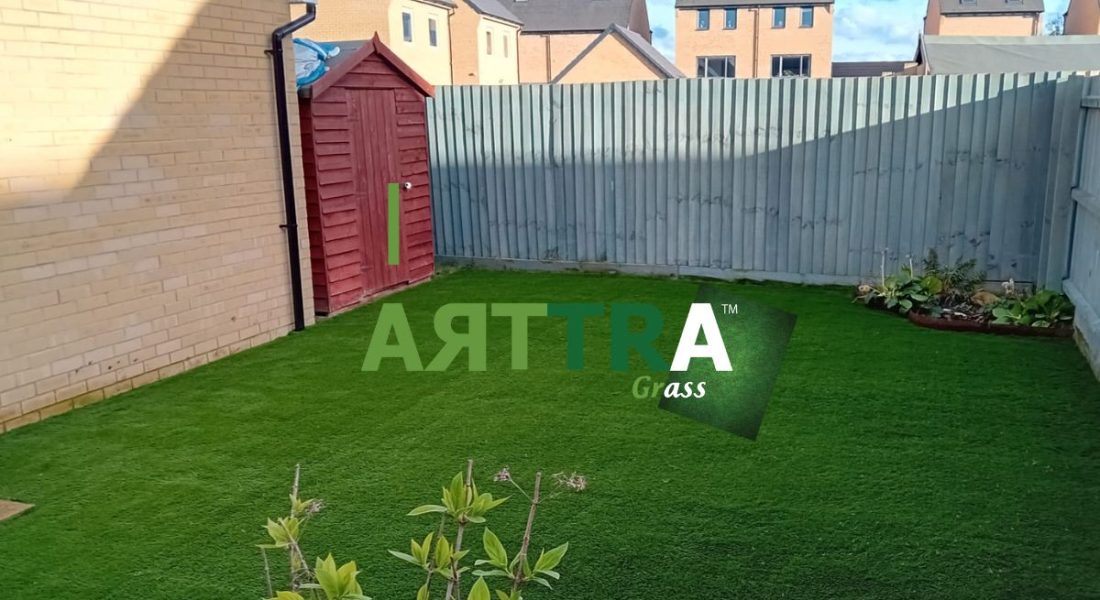
What Is The Best Solution for Drainage Issues in My Garden?
What is the best solution for drainage issues in my garden? A question asked by many homeowners in the UK. Drainage issues can make gardens difficult to use and maintain, particularly in areas with heavy clay soils like Milton Keynes, Bedford, Northampton, and Cambridge. Poor drainage often results in waterlogged lawns, muddy patches, and unusable outdoor spaces. Fortunately, solutions like artificial grass, combined with effective drainage systems, can transform even the most challenging gardens into functional, beautiful spaces.
In this article, I will explain the causes of poor drainage, the best solutions for tackling drainage problems, and how artificial grass can help create a low-maintenance and family-friendly garden.
Understanding Drainage Problems in Your Garden
What Causes Poor Drainage?
Several factors contribute to drainage issues in gardens:
- Clay Soil: Found commonly in Milton Keynes and surrounding areas, clay soil retains water, making it prone to waterlogging.
- Compacted Soil: Heavy foot traffic or machinery can compact soil, reducing its ability to absorb water.
- Improper Sloping: Flat or poorly graded gardens prevent water from draining naturally.
- New Builds: Many new-build properties in areas like Cambridge and Northstowe lack adequate garden drainage systems.
Signs of Drainage Issues
- Persistent puddles after rain
- Soggy or muddy lawns
- Patchy grass or dead spots
- Foul odours caused by stagnant water
Artificial Grass as a Solution to Drainage Problems
Artificial grass is an excellent choice for homeowners dealing with drainage issues. Its installation process includes proper groundwork to address drainage problems and create a level, usable surface.
How Artificial Grass Solves Drainage Issues
- Permeable Backing: High-quality artificial grass has a permeable backing, allowing water to flow through and drain into the ground below.
- Substrate Preparation: During installation, we use MOT Type 1 aggregate and granite dust to create a solid yet porous foundation. This ensures water flows away efficiently.
- Custom Drainage Solutions: For severe drainage problems, we install soakaways or French drainage systems to redirect excess water.
Case Study: Transforming a Flooded Garden in Northstowe, Cambridge
One of our recent projects in Northstowe, Cambridge, highlights how artificial grass can transform a waterlogged garden into a functional, family-friendly space.
The Problem
The homeowner, a father of two with a Golden Retriever, had been struggling with severe drainage issues in his back garden. The clay-heavy soil left the lawn muddy, patchy, and unusable for most of the year. The children couldn’t play outside without getting covered in mud, and the dog tracked dirt into the house daily.
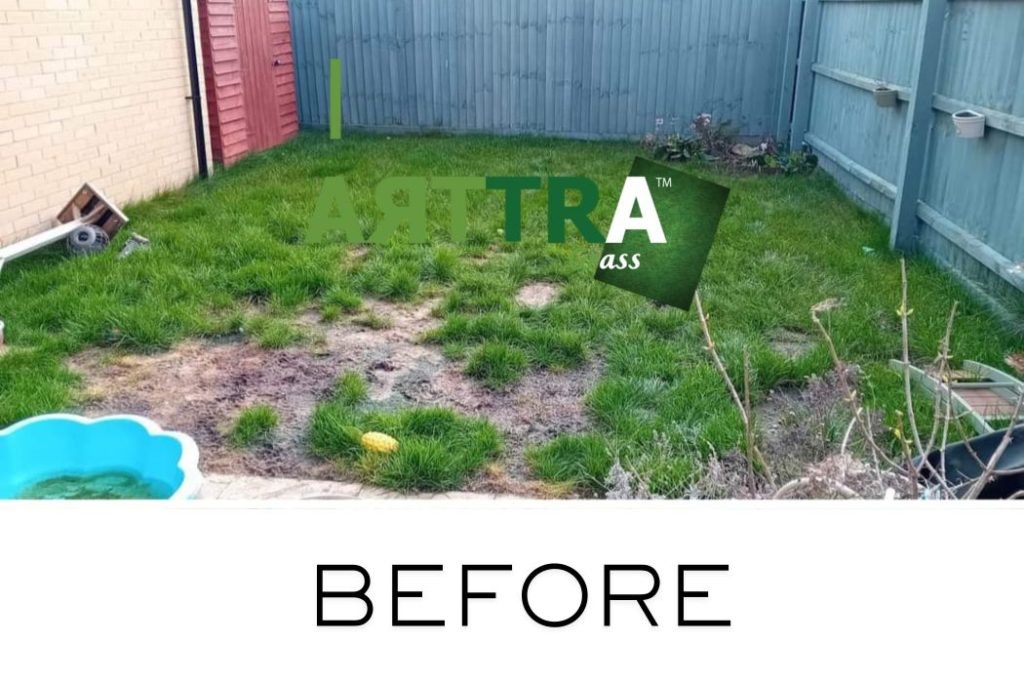
The Solution
We began by assessing the garden’s drainage needs. Our team:
- Removed the existing sod and excavated the top layer of compacted soil.
- Installed a layer of MOT Type 1 aggregate to create a stable, porous foundation.
- Added a layer of granite dust to improve drainage and provide a smooth surface for the artificial grass.
- For added drainage efficiency, we installed a French drain along the garden’s perimeter.
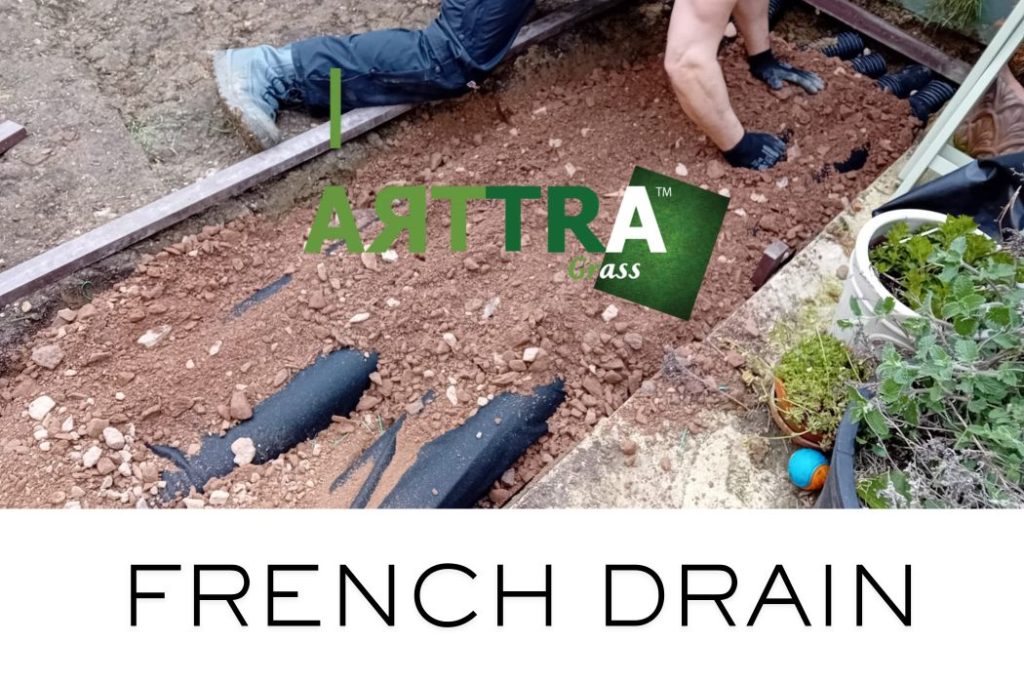
Finally, we laid premium artificial grass, which offered a durable, mud-free surface suitable for both children and pets.
The Results
The transformation was incredible. The garden is now a vibrant, usable space that remains dry and clean year-round. The family can enjoy outdoor playtime without worrying about mud or mess.
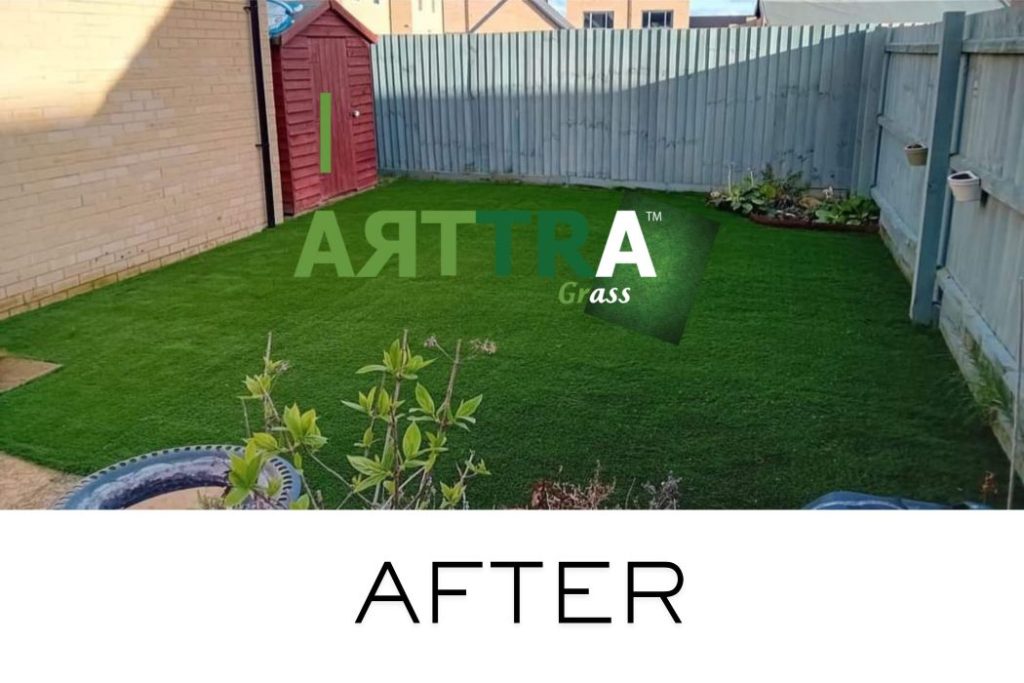
Why Artificial Grass is Perfect for Milton Keynes and Surrounding Areas
In regions like Milton Keynes, Bedford, Northampton, and Cambridge, drainage issues are common due to heavy clay soil and poor drainage systems in new builds. Artificial grass offers several benefits for homeowners in these areas:
1. All Year Round Usability
Artificial grass provides a mud-free surface that stays green and functional, no matter the weather.
2. Low Maintenance
Say goodbye to mowing, fertilising, and reseeding. Artificial grass requires minimal upkeep, making it ideal for busy families.
3. Pet- and Child-Friendly
Durable and soft, artificial grass is perfect for kids and pets to play on without worrying about muddy paws or stains.
4. Aesthetic Appeal
With its lush, natural look, artificial grass enhances the beauty of your garden while solving drainage problems.
Custom Drainage Solutions We Offer
While artificial grass can significantly improve drainage, severe issues may require additional measures. At ARTTRAGrass® Milton Keynes, we provide the following solutions:
1. MOT Type 1 and Granite Dust Installation
These materials create a porous foundation that allows water to drain effectively, preventing waterlogging.
2. Soakaways
A soakaway is a pit filled with gravel that collects and disperses excess water, keeping your garden dry.
3. French Drains
French drains are trenches filled with gravel and a perforated pipe that redirect water away from problem areas.
How to Maintain Your Artificial Grass and Drainage System
- Brush Regularly: Prevent debris buildup by brushing your artificial grass weekly.
- Check Drainage: Inspect your French drain or soakaway periodically to ensure they remain unblocked.
- Rinse as Needed: Hose down your artificial grass to remove dirt and pet waste.
Call-to-Action Conclusion
Struggling with drainage issues in your garden? Artificial grass could be the perfect solution for creating a beautiful, low-maintenance, and functional outdoor space. At ARTTRAGrass® Milton Keynes, we specialise in solving drainage problems and transforming gardens across Milton Keynes, Bedford, Northampton, Cambridge, and beyond.
Book before 31st March 2025 to receive a 20% discount on all installations!
Not sure about costs? Use our Artificial Grass Cost Calculator to estimate the price for your garden transformation. Contact us today to schedule a free consultation and take the first step toward your dream garden!
FAQs: What Is The Best Solution for Drainage Issues in My Garden?
- Can artificial grass help with drainage problems?
Yes, artificial grass is installed with drainage-friendly substrates like MOT Type 1 and granite dust, improving water flow. - What is a French drain?
A French drain is a trench filled with gravel and a perforated pipe that redirects water away from problem areas. - How much does it cost to install artificial grass?
Costs typically range from £50 to £75 per square metre, depending on factors like garden size and installation complexity. - Is artificial grass suitable for pets?
Absolutely! Artificial grass is durable, easy to clean, and resistant to pet stains and odours. - What areas do you serve?
We provide services in Milton Keynes, Bedford, Northampton, Cambridge, and throughout the UK. - How long does artificial grass last?
High-quality artificial grass can last 10-20 years with proper maintenance. - Will artificial grass look realistic?
Yes, modern artificial grass is designed to mimic the look and feel of natural grass. - Do I need to install a French drain for artificial grass?
In cases of severe drainage issues, a French drain may be necessary to improve water flow. - Is artificial grass eco-friendly?
Yes, it reduces water usage, eliminates the need for harmful chemicals, and requires no mowing. - How do I get a quote for artificial grass installation?
Use our Artificial Grass Cost Calculator or contact us for a free consultation.
The Best Solution for Drainage Issues in Gardens
Dealing with drainage problems in your garden? Artificial grass could be the ideal solution for achieving a stunning, low-maintenance outdoor space. Poor drainage is a common challenge, especially in new builds with heavy clay soil and ineffective drainage systems. So, the next time you ask yourself the question; ‘What is the best solution for drainage issues in my garden?’, artificial grass provides a practical and attractive solution, offering homeowners in Milton Keynes and places like Northstowe, a durable, hassle-free option to enhance their gardens while addressing drainage concerns effectively.
Transform your garden, contact us today with ARTTRAGrass® and enjoy a beautiful, mud-free outdoor space for years to come!
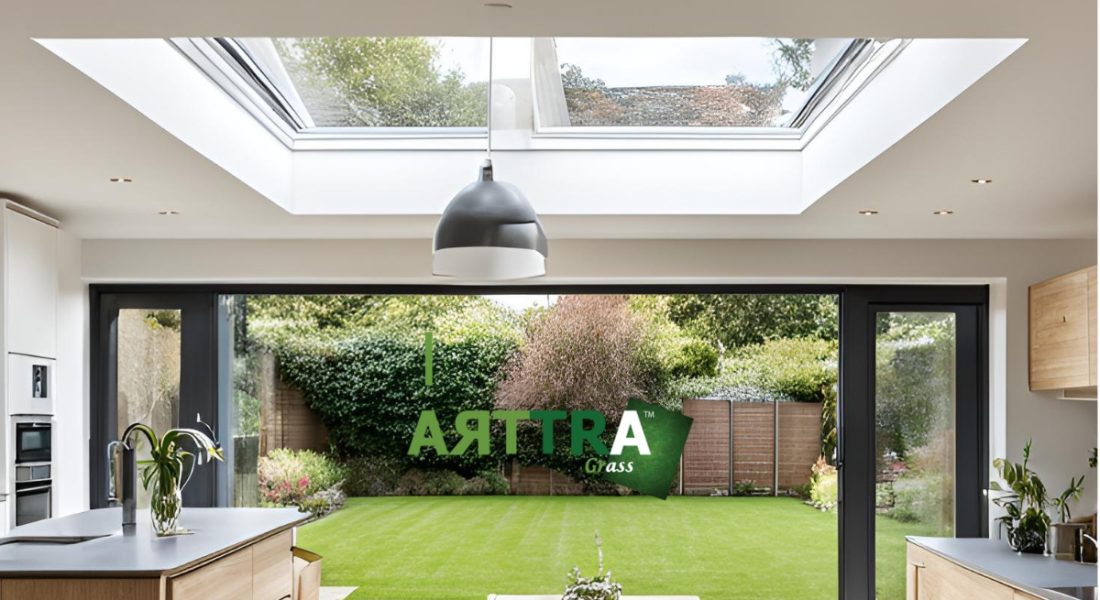
Can Artificial Grass Increase the Value of My House?
Artificial grass has become a popular landscaping solution for homeowners across the UK. With its low-maintenance appeal and year-round vibrancy, artificial turf offers benefits beyond aesthetics, including potential increases in property value. If you’re considering upgrading your outdoor space, you might wonder: Can artificial grass increase the value of my house? This article will explain how artificial grass can enhance your home’s worth while improving its usability and appeal.
What Is Artificial Grass and Why Is It Popular?
Artificial grass, also known as synthetic turf, is a man-made surface designed to replicate the look and feel of natural grass. Modern artificial grass is made using high-quality synthetic fibres that are durable, realistic, and low maintenance.
Why Homeowners Are Choosing Artificial Grass
- Low Maintenance: No mowing, watering, or fertilising is required.
- All-Weather Use: Artificial grass stays green and usable, even during winter months.
- Cost-Effective: Long-term savings on water and maintenance costs.
- Family-Friendly: Provides a safe, clean surface for children and pets.
- Versatility: Perfect for gardens, patios, balconies, and even indoor spaces.
How Artificial Grass Can Add Value to Your Home
Installing artificial grass is more than just a landscaping upgrade—it’s an investment in your property. Here’s how artificial turf can increase the value of your home:
1. Enhances Curb Appeal
First impressions matter. A well-maintained front garden with lush, green artificial grass creates a visually appealing exterior that can attract potential buyers. Artificial turf remains vibrant all year round, giving your home an inviting appearance no matter the season.
2. Attracts Modern Buyers
Today’s homebuyers value low-maintenance outdoor spaces. Artificial grass eliminates the hassle of lawn care, making it an attractive feature for busy families, professionals, and older buyers.
3. Creates Usable Outdoor Space
Artificial grass transforms your garden into a functional area for entertaining, relaxing, or playing. A low-maintenance, usable space is a significant selling point for buyers, particularly in urban areas where outdoor areas are limited.
4. Increases Energy Efficiency
A well-landscaped garden with artificial grass can help regulate your home’s temperature by reflecting heat during summer and retaining warmth in winter. Buyers looking for energy-efficient homes will appreciate this added benefit.
Real-Life Example: Artificial Grass for Families
A family with young children in Milton Keynes recently installed artificial grass in their back garden to create a play-friendly environment. The soft, durable surface provided a safe area for their kids to play all year round, increasing the garden’s usability. When the family later decided to sell their home, the low-maintenance garden with artificial grass became a key selling point, attracting multiple offers above the asking price.
The Cost vs. Value of Artificial Grass
While artificial grass requires an initial investment, its long-term value often outweighs the upfront costs.
Average Costs of Artificial Grass Installation in the UK
The cost of artificial grass installation ranges from £50 to £75 per square metre, depending on factors such as grass quality, installation complexity, and site preparation.
Return on Investment (ROI)
Homeowners can expect an ROI of 50-80% from installing artificial grass. This is due to increased buyer interest, higher property demand, and a boost in curb appeal.
Environmental Benefits of Artificial Grass
Installing artificial grass isn’t just a smart financial decision—it’s also an environmentally friendly one.
1. Saves Water
Unlike natural grass, artificial turf doesn’t require watering, which can significantly reduce your water usage and bills.
2. Eliminates Pesticides and Fertilisers
Artificial grass eliminates the need for harmful chemicals, promoting a safer and healthier environment for your family and pets.
3. Reduces Carbon Footprint
No mowing means less reliance on petrol-powered lawnmowers, reducing your carbon footprint.
ARTTRAGrass®: Premium Artificial Grass Solutions
At ARTTRAGrass® Milton Keynes, we specialise in transforming outdoor spaces with high-quality artificial grass that adds value and appeal to your home.
Why Choose ARTTRAGrass?
- Wide Range of Options: We offer a variety of grass types to suit different preferences and budgets.
- Expert Installation: Our professional team ensures a flawless finish for every project.
- Durability: Our artificial grass is designed to withstand heavy foot traffic, pets, and weather conditions.
- Local Expertise: We proudly serve Milton Keynes, Northampton, Cambridge, Bedford, and surrounding areas.
How to Maximise the Value of Artificial Grass
1. Choose the Right Grass Type
Selecting high-quality, realistic artificial grass is essential for achieving a natural look that appeals to buyers.
2. Invest in Professional Installation
A poorly installed lawn can detract from your home’s appearance and reduce its value. Always hire experienced professionals to ensure a seamless installation.
3. Incorporate Landscaping Features
Pair your artificial grass with features like patios, planters, or lighting to create an inviting outdoor space.
Grab Your Offer
Artificial grass is a valuable investment that enhances your home’s curb appeal, usability, and marketability. Whether you’re planning to sell your property or simply want to create a stunning outdoor space, artificial turf is a practical and visually appealing choice.
Ready to upgrade your garden with premium artificial grass? At ARTTRAGrass® Milton Keynes, we’re currently offering a 20% discount on all bookings made before 31st March 2025.
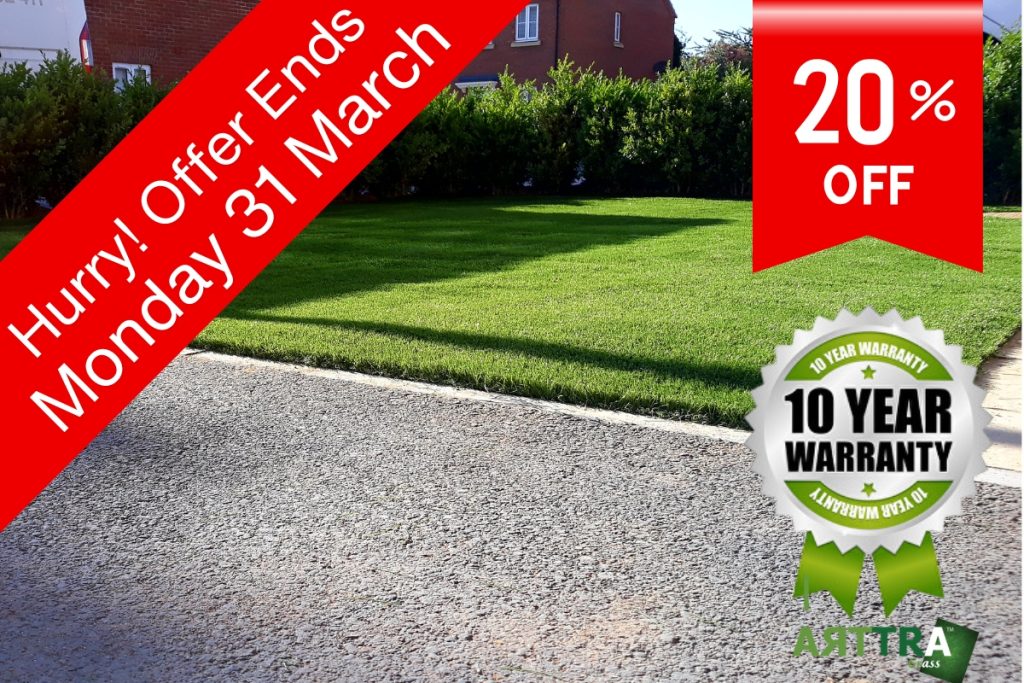
Use our Artificial Grass Cost Calculator to estimate your installation cost and take the first step toward transforming your garden. Contact us today to schedule your free consultation!
FAQs: Can Artificial Grass Increase the Value of My House?
- Can artificial grass increase the value of my home?
Yes, artificial grass enhances curb appeal, attracts modern buyers, and creates functional outdoor spaces, all of which can increase your home’s value. - Is artificial grass suitable for families with children?
Absolutely! Artificial grass provides a safe, soft surface for children to play on, making it ideal for families. - How long does artificial grass last?
High-quality artificial grass can last 10-20 years with proper care and maintenance. - Does artificial grass require a lot of maintenance?
No, artificial grass is low maintenance, requiring occasional brushing and cleaning to keep it looking its best. - Is artificial grass pet-friendly?
Yes, artificial grass is pet-friendly and resistant to wear, stains, and odours caused by pets. - What is the cost of installing artificial grass?
The cost typically ranges from £50 to £75 per square metre, depending on various factors. - Does artificial grass drain well?
Yes, modern artificial grass features drainage systems that prevent water pooling. - Can artificial grass help save on water bills?
Yes, artificial grass doesn’t require watering, which can lead to significant savings on water bills. - Can artificial grass be installed on uneven ground?
Yes, but the ground will need to be levelled and prepared before installation for the best results. - Do you offer artificial grass installation in Milton Keynes and nearby areas?
Yes, we provide professional installation services in Milton Keynes, Northampton, Cambridge, Bedford, and across the UK.
So, the next time you ask yourself, ‘Can artificial grass increase the value of my house?’, you know the answer is, yes! Start transforming your garden today with ARTTRAGrass® Milton Keynes Artificial Grass and experience the benefits of artificial grass for yourself. Book your installation now and take advantage of our exclusive discount!
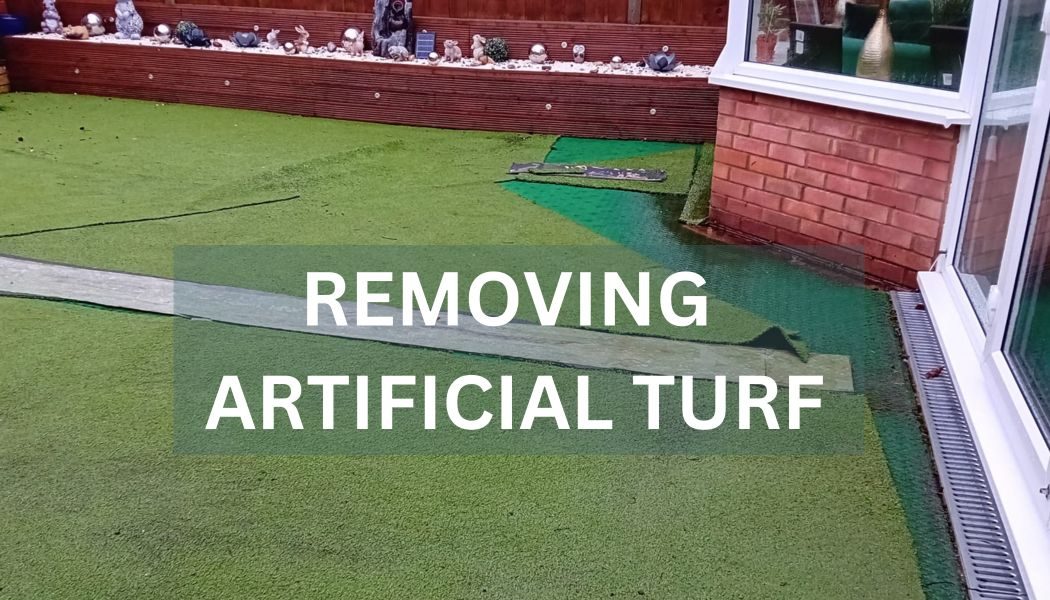
What Is The Cost To Remove Artificial Turf?
What is the cost to remove artificial turf? Artificial grass has become a popular choice for homeowners across the UK, offering a low-maintenance, visually appealing alternative to natural turf. However, there may come a time when you need to remove your existing artificial turf, whether due to wear and tear, a desire to upgrade, or a change in landscaping plans. In this article, we’ll explore the cost to remove artificial turf, explain why we offer this service for FREE when you choose ARTTRAGrass® for your replacement, and provide tips to make your garden transformation seamless.
Factors Affecting the Cost to Remove Artificial Turf
Several elements influence the cost of removing artificial turf:
- Size of the Area: Larger areas require more time and labour, increasing the overall cost.
- Type of Installation: If the turf is installed with heavy-duty adhesive or includes an intricate base system, removal may take longer and incur higher costs.
- Accessibility: Easy access to the removal site can reduce labour costs, while tight spaces or restricted access may increase them.
- Disposal Fees: Disposing of old turf responsibly adds to the overall expense.
The Cost to Remove Artificial Turf in the UK
On average, the cost to remove artificial turf ranges from £10 to £20 per square metre. This price includes labour and disposal fees, but additional costs may apply depending on the complexity of the project.
Why Choose ARTTRAGrass?
At ARTTRAGrass®, we simplify the process for our customers by offering turf removal FREE OF CHARGE when you opt for our supply and installation services. Our commitment to customer satisfaction means you can upgrade your garden without worrying about additional removal fees.
The Process of Removing Old Artificial Turf
Removing artificial turf involves several steps to ensure the area is clean and ready for new installation.
- Inspection: Our team assesses the site to determine the most efficient removal method.
- Turf Cutting: The old turf is carefully cut into manageable strips for removal.
- Base Removal: Depending on the base material, we remove sand, adhesive, or hardcore layers.
- Disposal: The removed materials are disposed of responsibly, adhering to environmental regulations.
- Site Preparation: The area is levelled and prepared for the new artificial grass installation.
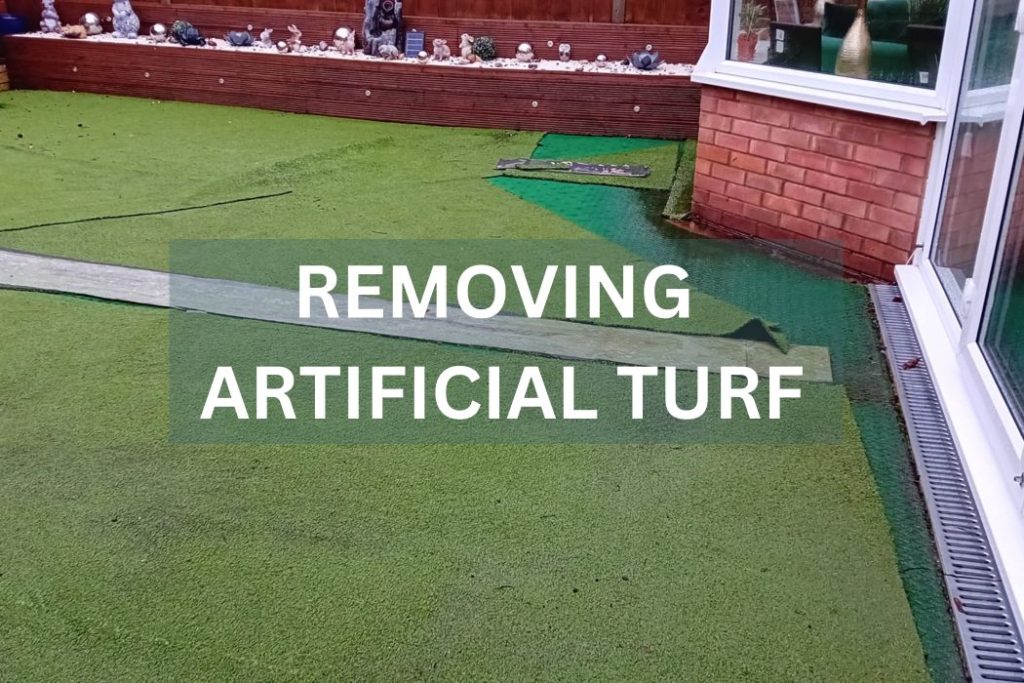
Why Homeowners Remove Artificial Turf
Upgrading to Premium Grass
Many homeowners choose to replace their old turf with higher-quality artificial grass. ARTTRAGrass® offers durable, visually appealing options that enhance your outdoor space.
Addressing Wear and Tear
Over time, artificial grass may show signs of wear, including flattening, discolouration, or damage. Removing and replacing old turf can rejuvenate your garden.
Changing Landscaping Plans
Whether you’re adding a patio, creating a play area, or revamping your garden design, removing artificial turf allows you to start fresh.
The ARTTRAGrass® Difference
Supply and Install Services
We provide a full-service solution, from removing your old turf to installing premium ARTTRAGrass® artificial grass. Our products are designed to withstand the UK climate, offering all-year-round beauty and functionality.
No Hidden Costs
When you choose ARTTRAGrass®, the cost to remove artificial turf is completely free. This transparency ensures you know exactly what to expect.
Areas We Serve
We proudly serve homeowners across the UK, with a focus on the following areas:
- Milton Keynes
- Northampton
- Cambridge
- Bedford
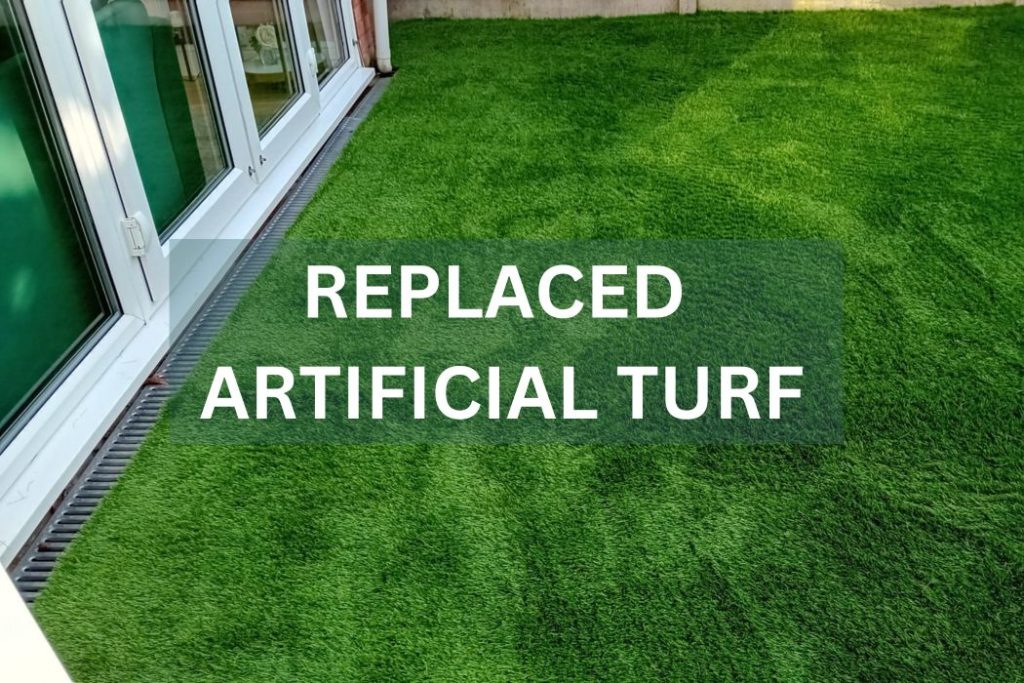
Benefits of Replacing Artificial Turf
- Improved Aesthetics: New artificial grass can dramatically enhance your garden’s appearance.
- Enhanced Functionality: Modern turf options are more durable and versatile, suitable for play areas, pets, and outdoor activities.
- Increased Property Value: A well-maintained garden with premium artificial grass can boost your home’s appeal.
Call-to-Action Conclusion
Ready to transform your garden? Now is the perfect time to upgrade your artificial turf with ARTTRAGrass®. We are currently offering a 20% discount on all bookings made before 31st March 2025. Take advantage of this limited-time offer and let us handle the turf removal for FREE when you choose our supply and install service.
To estimate the cost of installing artificial grass in your garden, visit our Artificial Grass Cost Calculator. Simply enter the dimensions of your garden to receive an instant quote and take the first step towards your dream outdoor space.
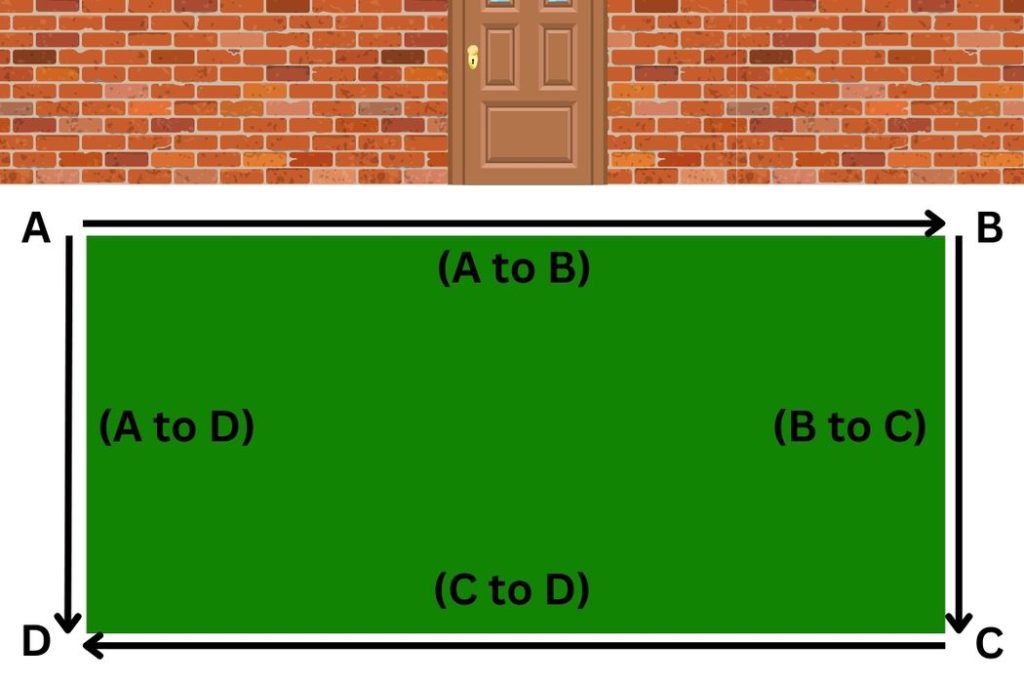
Frequently Asked Questions: The Cost To Remove Artificial Turf
- How much does it cost to remove artificial turf?
On average, removal costs range from £10 to £20 per square metre, but it’s free with ARTTRAGrass® when you book our supply and install service. - Is turf removal included in the installation service?
Yes, we offer free turf removal as part of our installation package. - How long does it take to remove artificial turf?
The timeframe depends on the size and complexity of the area but typically takes a few hours to a day. - Do you dispose of the old turf?
Yes, we handle all disposal responsibilities, ensuring compliance with environmental standards. - Can I remove artificial turf myself?
While possible, professional removal ensures proper handling and saves you time and effort. - What types of artificial grass do you supply?
We offer a wide range of premium ARTTRAGrass® products suitable for various needs. - Do you offer services in areas outside Milton Keynes, Northampton, Cambridge, and Bedford?
Yes, we serve customers across the UK. Contact us to discuss your location. - How do I book the 20% discount offer?
Contact us before 31st March 2025 to schedule your service and secure the discount. - Is the new artificial grass pet-friendly?
Absolutely! Our turf is designed to be safe and comfortable for pets. - How can I get an accurate quote for my project?
Use our Artificial Grass Cost Calculator or contact us for a detailed quote.
Upgrade your garden today with ARTTRAGrass and enjoy a hassle-free transformation. Contact us at 0800 433 2353 or 01908 477 145 for a free no-obligation quote and take advantage of our limited-time 20% discount!
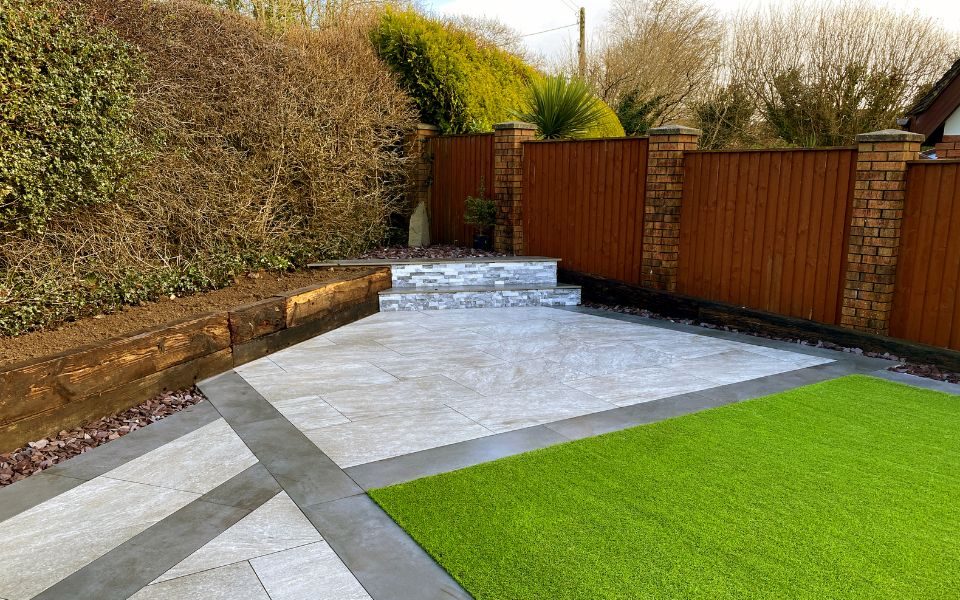
Can I Have Artificial Grass If There Is No Access to My Backyard?
Can I have artificial grass if there is no access to my backyard? Yes, you can still have artificial grass installed in your backyard even if there’s no direct access.
Can I Have Artificial Grass If I Live In A Mid-Terrace House?
Installing artificial grass in your backyard can transform it into a low-maintenance, green oasis. However, if there’s no direct access to your backyard, you might wonder if it’s still possible to enjoy the benefits of synthetic turf. Mid-terrace homeowners, especially in London, usually experience this issue. But at ARTTRAGrass Milton Keynes Artificial Grass, we always have a solution for this. Let’s explore the options available for installing artificial grass when traditional access routes are limited.
Assess Accessibility Options
First, assess the accessibility options available to reach your backyard. Explore alternative routes, such as side gates, pathways, or neighbouring properties with permission. Measure these routes to ensure they can accommodate the transportation of materials and equipment.
- Side Passages: Many terrace houses have side passages that lead to the backyard. Assess whether there’s a side passage that can be used to transport materials and equipment for artificial grass installation.
- Front Access: In some cases, it may be possible to access the backyard through the front of the house or neighbouring properties with permission. Coordinate with installers to determine if this is a feasible option.
Coordinate with Professionals
We are artificial grass specialists who have experience navigating challenging access situations. We can assess your property and provide insights into the best approach for transporting materials and equipment to your backyard.
- Experienced Installers: Our artificial grass installers have experience working in urban environments and navigating access challenges. We will assess your property and suggest the best approach for installation.
- Alternative Methods: Our installers may suggest alternative methods for transporting materials and equipment, such as using smaller machinery or breaking down materials into smaller pieces for easier transport.
Consider Installation Methods
Choose installation methods that minimise disruption and simplify logistics. Roll-out synthetic turf may be more manageable than pieces requiring assembly. Alternatively, consider modular sub-bases or sectional installations that can be transported in smaller pieces.
Explore Temporary Solutions
For temporary or smaller-scale projects, consider synthetic grass mats or tiles that can be easily transported and installed without heavy equipment. These temporary solutions can provide flexibility until a more permanent installation method becomes feasible.
- Synthetic Grass Mats: You may also want to consider using artificial grass mats or tiles for temporary installations. These can be transported in smaller pieces and easily installed without heavy equipment.
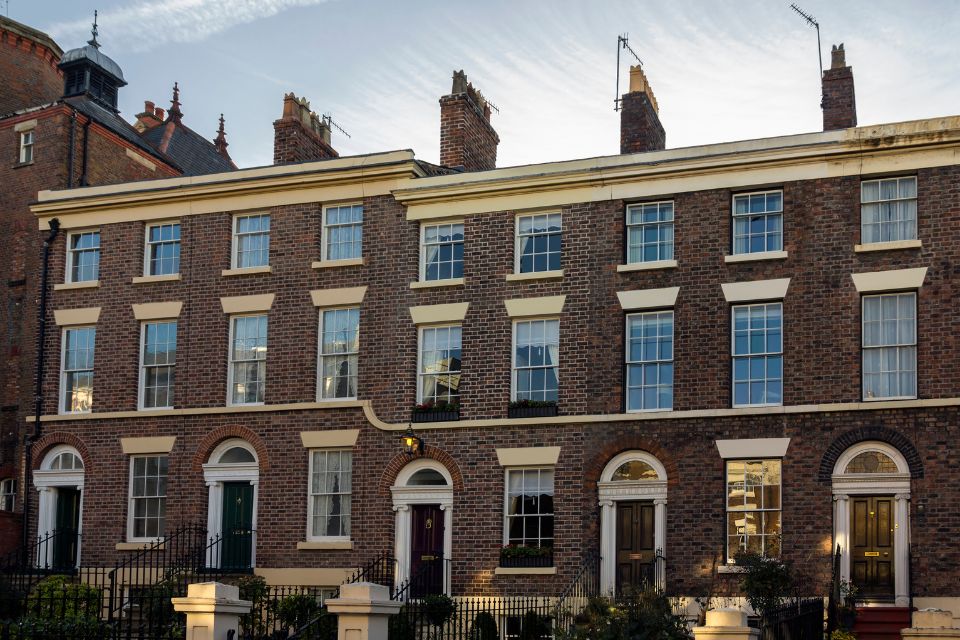
Coordinate With Your Neighbours
If neighbouring properties have easier access to your backyard, seek their cooperation and permission to use their access points for installation purposes. Clear communication and cooperation with neighbours can facilitate a smoother installation process.
Plan Ahead
Plan the installation timeline carefully to coordinate with any necessary permissions, equipment rentals, or transportation arrangements. Communicate clearly with our installers to ensure everyone is on the same page regarding access and logistics.
Case Study – Mr McGrath (Mid-Terrace House – Paddington)
- Introduction
- Mr. and Mrs. McGrath had a garden that suffered from the lack of sunlight, which ended up in their grass constantly getting muddy patches. With three young children, the garden was hardly used by the family.
- The problem we faced was getting the soil out through the house as there was no access through the back garden. Another challenge was that, due to the length of the grass roll, it was impossible to get the grass through the corridors and through the doors.
- Problem Statement
- The client was very particular about any marks or scratches that the grass roll would cause on their walls. They also expressed their concerns about the possibility of their parquet floors being scratched by our wheel barrows.
- This problem was significant and impactful because, in order to get all the substrate through the house, we had to use a wheel barrow. Also, the grass roll had to fit through.
- The customer could not ask the neighbours for permission to access his garden through theirs, due to past bad experiences.
- Solution and Implementation
- After assessing everything, we decided that removing the existing lawn wasn’t feasible. We then explained our Risk And Method Statement to the customer and reassured them.
- We decided to lay a floor protector all over the floors, in order to push the wheelbarrow through the house.
- We used multiple 25 kg bags of MOT Type 1 and sharp sand, instead of the usual 850kg or tonne bags. This was challenging and an expensive option.
- We also had to remove the sash windows in order to fit the 4m long, 160kg artificial grass roll through.
- Impact
- The customer was extremely delighted, which led to them recommending our company to some of their very high profile friends, colleague, and also, their families.
- Lessons Learned
- The key takeaways from this project was that, though it was a project that many of our competitors had rejected, due to its complexity, out team tackled it in a professional manner. The customer’s recommendations led to installing our brand of artificial grass to many high profile customers including A-list celebrities in London.
- This experience helped us to spot a gap in the market, which made us start taking on complex installations for our future projects.
- Summary
- Even though we had the initial obstacle which made the customer feel there was no hope, we used our expertise and knowledge to deliver them with a lush garden.
- Finally, we were able to successfully complete the project, and provide the family with a stunning all year round outdoor space.
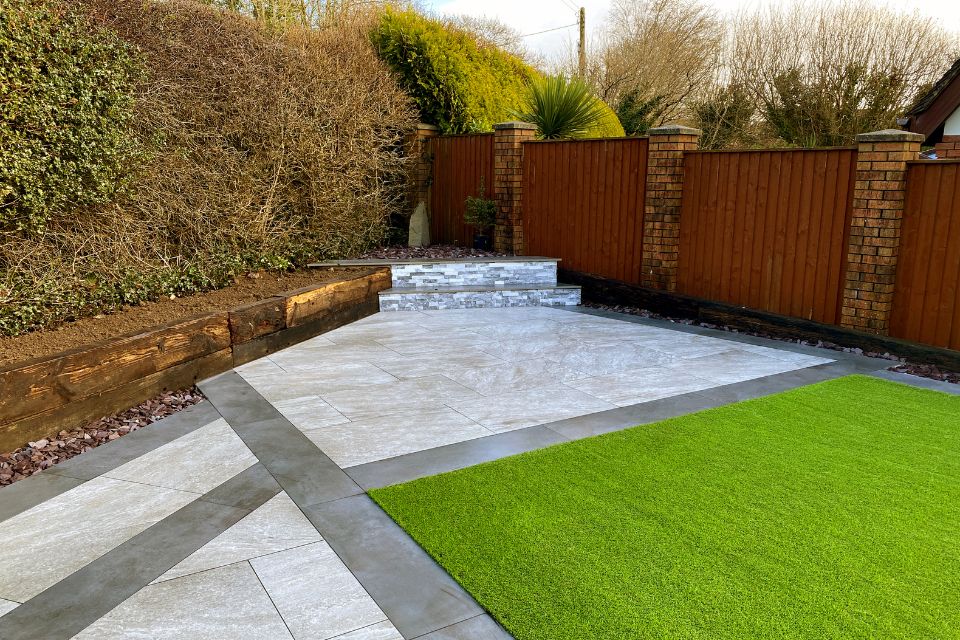
FAQs: Can I Have Artificial Grass If There Is No Access to My Backyard
Q1: Is it possible to install artificial grass without direct backyard access?
Yes, it’s possible to install artificial grass even if there’s no direct access to your backyard. By exploring alternative routes, coordinating with our professionals, and considering installation methods, you can overcome accessibility challenges.
Q2: What are the options for transporting materials and equipment to the backyard?
Explore alternative routes such as side gates, pathways, or neighbouring properties with permission. Additionally, consider smaller, more manageable installation methods like synthetic grass mats.
Q3: How can I ensure that the installation process goes smoothly?
Coordinate with our experienced artificial grass installers who have expertise in navigating challenging access situations. Plan ahead and communicate clearly to address any potential logistical challenges.
Q4: Are there temporary solutions available for limited backyard access?
Yes, synthetic grass mats or tiles can provide temporary solutions for smaller-scale projects. These can be easily transported and installed without heavy equipment.
Q5: Can I use my neighbour’s access route for installation?
With permission from your neighbours, it may be possible to use their access points for transporting materials and equipment to your backyard. Clear communication and cooperation are essential in this scenario.
Q6: What factors should I consider when planning the installation timeline?
Consider factors such as permissions, equipment rentals, transportation arrangements, and the availability of installers. Plan the timeline accordingly to ensure a smooth and efficient installation process.
Q7: Will the lack of direct access impact the cost of installation?
The cost of installation may vary depending on factors such as the complexity of the access route, transportation requirements, and the chosen installation method. Discuss these considerations with our installation team to determine the most cost-effective approach.
Q8: Can I install artificial grass myself without professional assistance?
While DIY installation is possible, it may be more challenging in situations with limited access. Our team of professional installers have the expertise and equipment necessary to navigate such challenges effectively.
Q9: Are there any restrictions or regulations regarding backyard access for installation purposes?
Check with local authorities or homeowners’ associations for any regulations or restrictions regarding backyard access for installation purposes. Ensure compliance with any applicable rules or guidelines.
Q10: What are the benefits of installing artificial grass despite limited backyard access?
Installing artificial grass can still provide numerous benefits, including a low-maintenance, green outdoor space that enhances the aesthetics and usability of your property. With careful planning and coordination, you can overcome accessibility challenges and enjoy the beauty of faux turf in your backyard.
Conclusion
While limited access to your backyard may present challenges, with careful planning and coordination, it’s still possible to have artificial grass installed. By exploring alternative routes, coordinating with professionals, considering installation methods, and planning ahead, you can enjoy the benefits of faux lawn in your backyard, even without direct access. With the right approach, you can create a beautiful, low-maintenance outdoor space that enhances the aesthetics and functionality of your property.
If you a live in or own a mid-terrace house and are looking for a professional artificial grass installer in Milton Keynes, surrounding areas or London, please do not hesitate to contact us at 0800 433 2353. Alternatively, you can contact us via email at enquiries@miltonkeynesartificialgrass.co.uk or click here. We cover the whole of Bedfordshire, Berkshire, Buckinghamshire, Cambridgeshire, Hertfordshire, Northamptonshire, Oxfordshire, and the London area.
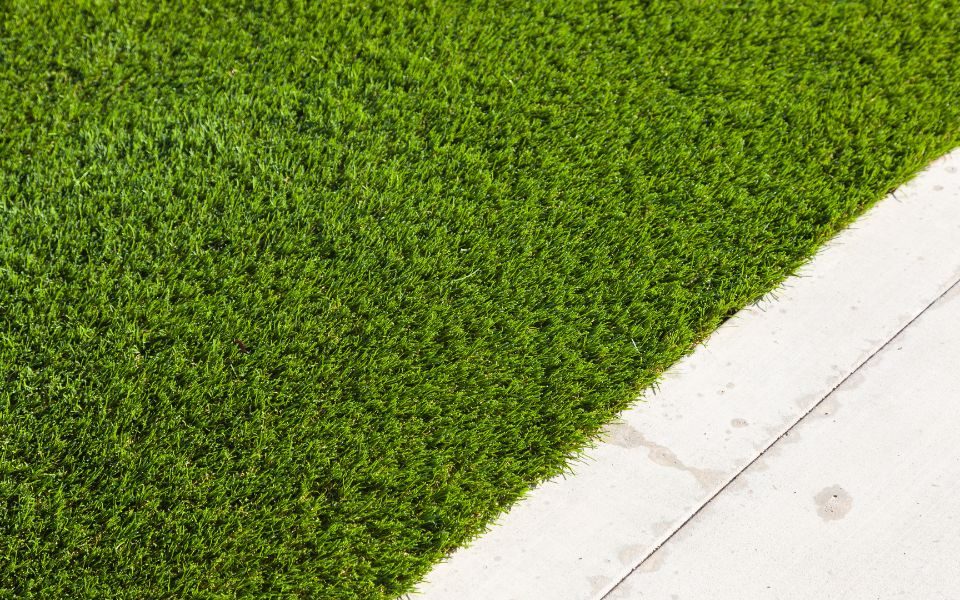
What are the signs that it’s time to replace artificial grass?
What are the signs that it’s time to replace artificial grass? Knowing when it’s time to replace artificial grass is essential to maintain the aesthetics and functionality of outdoor spaces. Here are the signs that indicate it’s time for replacement. See picture below.
Signs It’s Time to Replace Artificial Grass
Artificial grass has gained popularity for its low maintenance and long-lasting properties, but like any outdoor surface, it requires periodic replacement to maintain its aesthetics and functionality. Recognising the signs that indicate it’s time to replace your artificial grass is crucial for preserving the look and usability of your outdoor living space. Let us explore the tell-tale signs that suggest artificial grass replacement is necessary and provide insights into the process.
Matting and Flattening
Over time, artificial grass fibres may become flattened or matted, particularly in high-traffic areas. Excessive matting not only affects the appearance of the grass but also compromises its functionality. When the fibres lose their resilience and bounce-back capability, the grass may appear worn out and less vibrant.
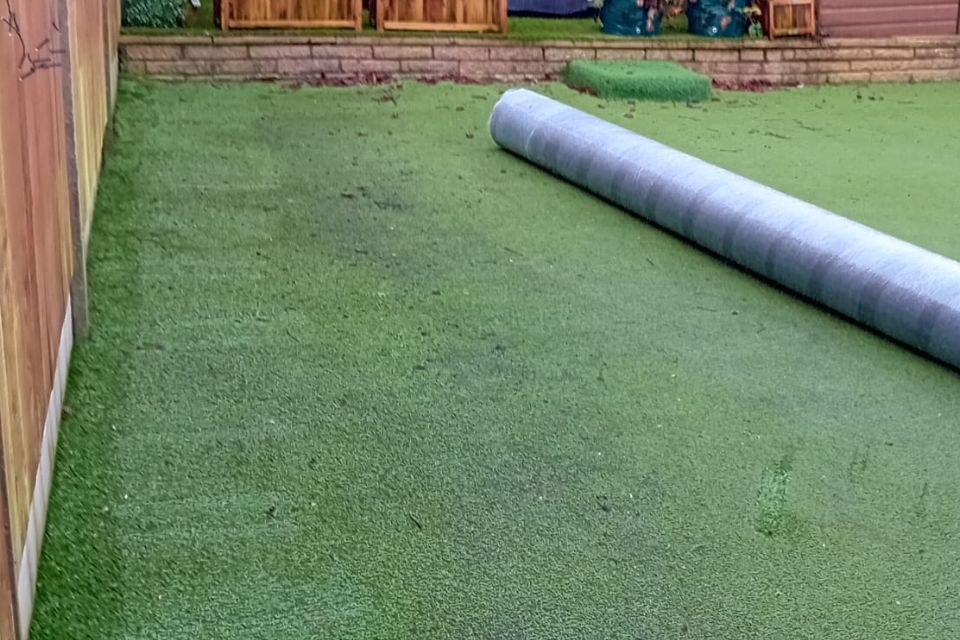
Fading
Prolonged exposure to extreme sunlight can cause artificial grass to fade over time. Fading is a common issue, especially in regions with intense sunlight or extreme weather conditions. The once vibrant green colour may become dull or discoloured, detracting from the overall aesthetic appeal of your garden.
Damage
Damage from various sources, such as pets, sharp objects, or heavy furniture, can compromise the integrity of artificial grass. Tears, holes, or rips in the grass are not only unsightly but also be a trip hazard. If the damage is extensive and cannot be effectively repaired, a replacement may be the best solution.
Poor Drainage
Effective drainage is essential for maintaining the health and longevity of artificial grass. Poor drainage can result in water pooling on the surface, leading to issues such as mould growth, unpleasant smells, and potential damage to the backing material. Despite efforts to address drainage problems, persistent issues may necessitate replacement.
Smells
Accumulation of organic debris, such as pet waste or leaves, can lead to unpleasant smells over time. Despite regular cleaning, persistent smells may indicate underlying issues with the artificial grass that warrant replacement. Proper drainage and ventilation are essential for preventing odour build-up in artificial grass.
Mould or Mildew Growth
Inadequate drainage or prolonged exposure to moisture can create an environment conducive to mould or mildew growth. If mould or mildew is present on the surface or backing of the artificial grass, replacement may be necessary to ensure a healthy and safe outdoor environment. Regular cleaning and proper maintenance can help prevent mould growth.
Excessive Wear and Tear
High-traffic areas or areas subjected to heavy use may experience accelerated wear and tear over time. Signs of excessive wear and tear include fraying edges, exposed backing material, or visible signs of deterioration that cannot be remedied through maintenance. If the grass fibres are significantly worn down, replacement may be the most viable option.
Visible Stains or Discolouring
Stubborn stains or discolouring that cannot be removed through regular cleaning may detract from the overall appearance of the artificial grass. If stains persist and compromise the aesthetic appeal of the area, replacement may be the best course of action. Choosing stain-resistant artificial grass can help minimise discolouring over time.
Loss of Resilience
As artificial grass ages, it may lose its resilience and bounce-back capability, resulting in a flat or compressed appearance. Loss of resilience can affect the performance of the grass, particularly in areas where shock absorption is important, such as kids playgrounds or sports fields. If the grass feels flat and lacks elasticity, it may be time for replacement.
Age
Like any outdoor surface, artificial grass has a finite lifespan and will eventually require replacement. If the artificial grass is nearing the end of its expected lifespan and exhibiting multiple signs of wear and tear, replacement may be necessary to maintain the integrity and functionality of your garden. Regular inspections and proactive maintenance can help prolong the lifespan of your artificial grass.
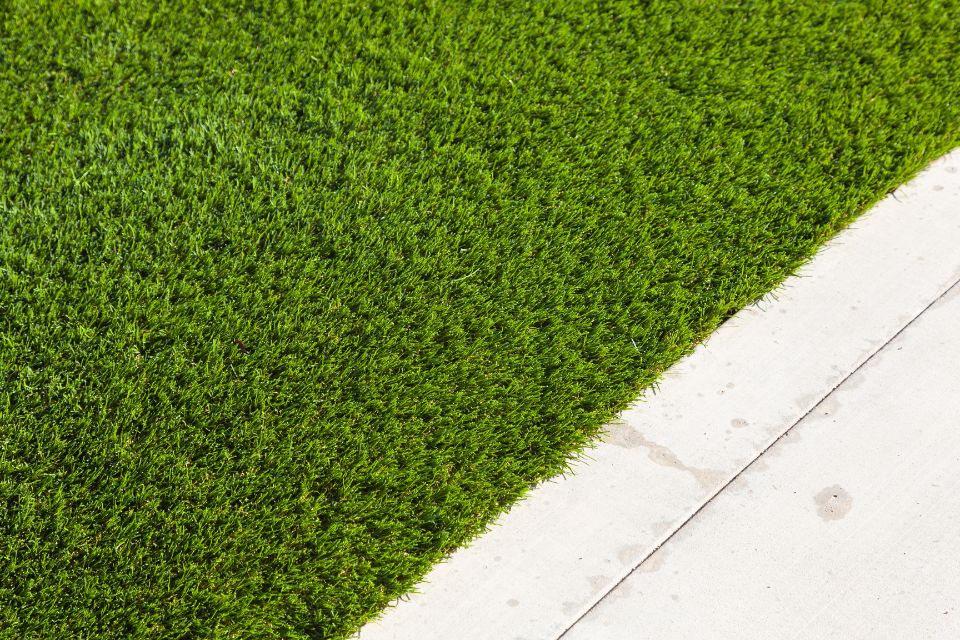
Frequently Asked Questions (FAQs)
Q1: How long does artificial grass typically last?
Artificial grass can last up to 15 to 25 years or more with proper care and maintenance, depending on factors such as the initial installation, quality, usage, and environmental conditions.
Q2: Can artificial grass be repaired instead of replaced?
In some cases, minor damage or wear and tear can be repaired through patching or seam repair. However, extensive damage or degradation may require replacement of the entire area.
Q3: What are the benefits of replacing artificial grass?
Replacing artificial grass restores the aesthetic appeal and functionality of your garden or outdoor spaces, improving drainage, reducing smells, and enhancing safety.
Q4: How often should artificial grass be cleaned?
Routine cleaning of artificial grass, including removing debris and pet waste, should be performed as needed to maintain its appearance and functionality. Additionally, professional cleaning may be recommended periodically to remove embedded dirt and bacteria.
Q5: Can artificial grass fade over time?
Thought very rare, prolonged exposure to extreme sunlight can cause artificial grass to fade over time. A good artificial grass should be Ultra Violet resistant which helps mitigate fading.
Q6: What are the environmental benefits of artificial grass replacement?
Replacing artificial grass with newer, more sustainable materials like the ARTTRAGrass® 100% recyclable artificial grass can reduce water usage, as it drains 5x faster than standard alternatives. Having artificial turf installed also minimises the need for chemical fertilizers and pesticides, and promote eco-friendly landscaping practices.
Q7: How much does it cost to replace artificial grass?
The cost of replacing artificial grass depends on factors such as the size of the area, the quality of the material, and any additional preparatory work required. On average, replacement costs approximately £60 per sqm.
Q8: Can artificial grass be recycled?
Yes, many artificial grass manufacturers offer recycling programs for old or worn-out artificial grass, diverting it from landfills and repurposing it for other applications.
Q9: What are the benefits of professional installation for artificial grass replacement?
Professional installation ensures proper preparation, installation, and finishing of the artificial grass, resulting in a long-lasting and aesthetically pleasing garden.
Q10: How can I determine if my artificial grass needs replacement?
Inspecting the artificial grass for signs of wear and tear, poor drainage, smells, or mould growth can help determine if replacement is necessary. Our professional team of installers can provide further guidance based on the specific condition of your current natural grass.
In a Nutshell
Recognising the signs that indicate it’s time to replace artificial grass is essential for maintaining the aesthetics and functionality of your garden. Whether it’s excessive wear and tear, fading, damage, or drainage issues, addressing these signs promptly can help prevent further deterioration and ensure a long-lasting and aesthetically pleasing outdoor environment. By staying vigilant and proactive in monitoring the condition of artificial grass, you can make informed decisions about when to invest in replacing your lawn, ultimately enhancing the enjoyment and value of your garden.
If you a looking for a professional artificial grass installer in Milton Keynes, and surrounding areas, do not hesitate to contact us at 0800 433 2353. Alternatively, you can contact us via email at enquiries@miltonkeynesartificialgrass.co.uk or click here. We cover the whole of Bedfordshire, Berkshire, Buckinghamshire, Cambridgeshire, Hertfordshire, Northamptonshire, Oxfordshire, and the London area.
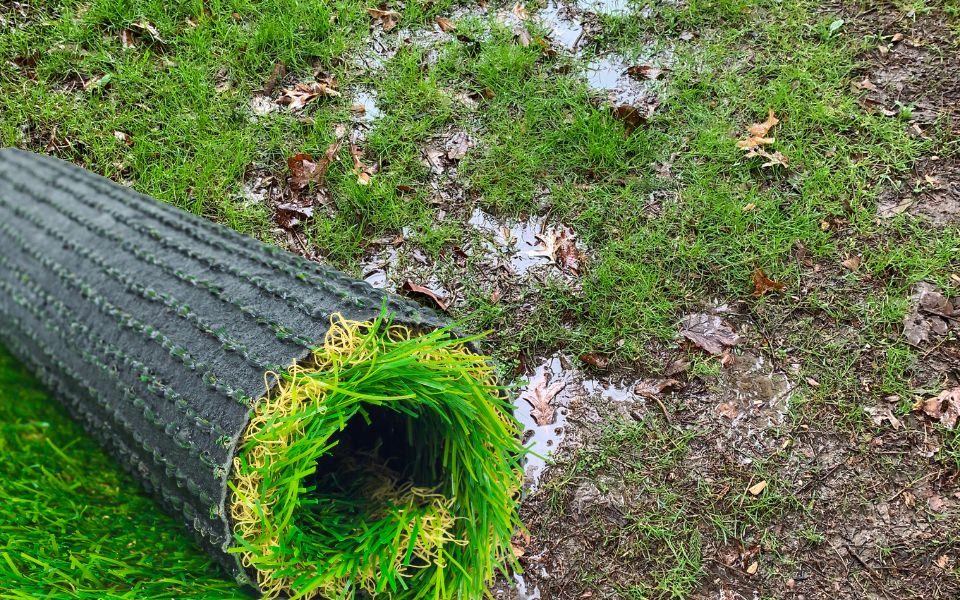
Can I Install New Artificial Grass Over Existing Turf?
Can I install new artificial grass over existing turf? Yes, installing new artificial grass over existing turf is possible in certain situations, but it requires careful consideration and preparation. Here’s what you need to know.
Installing new artificial grass over existing turf can be a practical and cost-effective solution for rejuvenating outdoor spaces. However, several factors need to be considered to ensure a successful installation process and optimal long-term performance. Let me explain the steps involved in installing artificial grass over existing turf, potential challenges, and frequently asked questions to help you make an informed decision.
Assessing the Feasibility
Before embarking on the installation process, it’s essential to assess the feasibility of installing new artificial grass over existing turf. Consider the following factors:
Condition of the Existing Turf
Evaluate the condition of the existing turf to determine if it is suitable for installation. Ensure that the turf is relatively flat, free of major damage, and has adequate drainage.
Compatibility of Materials
Ensure that the new artificial grass is compatible with the existing turf and suitable for installation over it. Some types of artificial grass may not adhere well to certain surfaces, so it’s essential to choose the right product.
Preparation Steps
Once you’ve determined the feasibility of installing artificial grass over existing turf, follow these preparation steps:
Clearing Debris
Thoroughly clean the existing turf to remove any debris, vegetation, or organic matter. Use a leaf blower, rake, or power broom to clear the turf effectively. It may be wise to add some sort of substrate to make it even and more sturdy when stood on. Using a compactor (Wacker plate) or a manual tamper to compact it and level it.
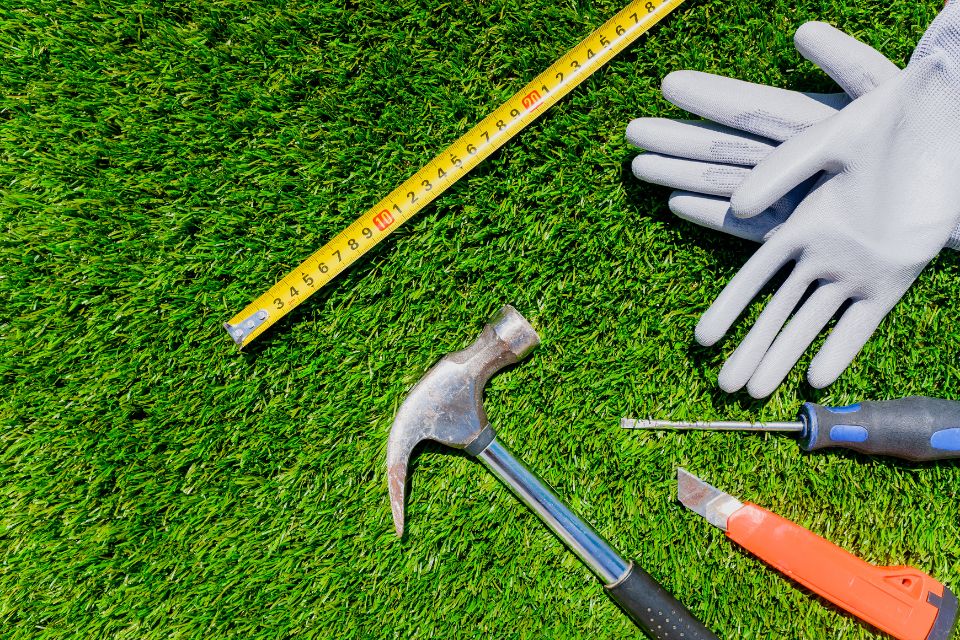
Addressing Drainage Issues
Check the drainage system of the existing turf to ensure that water can flow freely and efficiently. Make any necessary adjustments or improvements to the drainage system before proceeding with the installation.
Adding a Weed Barrier
To prevent weeds from growing through your new artificial grass, consider adding a weed suppressing membrane over the existing turf. You may want to use some sub-base as well. This will help suppress weed growth and provide a stable base for the artificial grass.
Installation Process
Once the preparation steps are complete, you can proceed with the installation process:
Laying Out the Artificial Grass
Carefully lay out the new artificial grass over the existing turf, ensuring that it is positioned evenly and securely, with the pile facing the property, ideally. Use adhesive or seaming tape to join the seams and secure the edges of the artificial grass.
Trimming and Shaping
Trim and shape the artificial grass as needed to fit the contours of the area. Use a sharp utility knife like a Stanley knife to cut the grass to size, ensuring clean and precise edges.
Securing the Edges
Secure the edges of the artificial grass with landscape staples or galvanised nails to a sturdy structure, like a treated timber frame, to prevent shifting or movement. Use a knee kicker if possible to stretch it out, to avoid creases. Ensure that the edges are securely anchored to the structure for a stable installation.
Considerations and Limitations
While installing new artificial grass over existing turf can be a convenient option, there are some limitations and considerations to keep in mind:
- Compatibility: Ensure that the backing of your new artificial grass is not too soft and bendy. Be aware that in hot seasons, the artificial grass turn to soften a bit, hence the need to use the substrates as a base.
- Surface Preparation: Proper surface preparation is essential for a successful installation. Neglecting to use the right substrate can result in problems with the artificial grass installation.
- Long-Term Performance: Consider the long-term performance and durability of the installation. Factors such as a sturdy base, (using MOT type 1 with sharp sand on top or granite dust), drainage, compaction, and stability may impact the lifespan of the artificial grass.
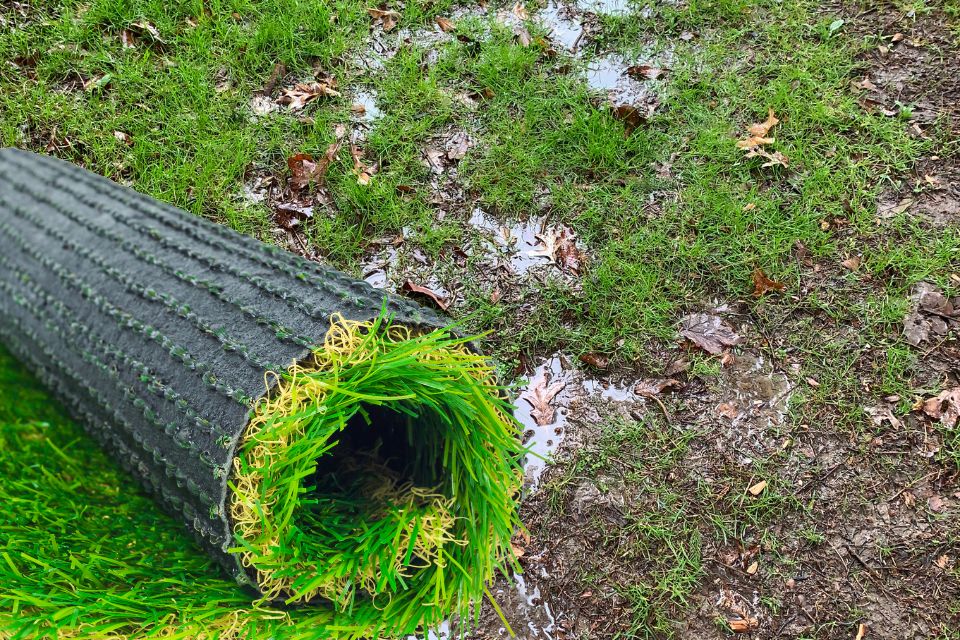
Frequently Asked Questions (FAQs): Can I Install New Artificial Grass Over Existing Turf?
Q1: What is the main benefit of installing new artificial grass over existing turf?
Installing new artificial grass over existing turf can save time and money, especially if you live in a terrace house where removing the old turf could be a bit of an inconvenience.
Q2: Can I install artificial grass over any type of existing turf?
In most cases, artificial grass can be installed over existing turf, but it’s essential to ensure that the existing turf is relatively flat, using some substrate, free of major damage, and has adequate drainage.
Q3: How do I prepare the existing turf for installation?
Preparation steps include clearing debris, addressing drainage issues, adding a sub-base and weed membrane to prevent weed growth through the new artificial grass.
Q4: What tools and materials do I need for the installation process?
You’ll need basic landscaping tools such as a leaf blower, rake, sharp utility knife, scissors, artificial grass adhesive, seaming tape, screws, some timber or metal for the edging, landscape staples or nails, and a weed suppressing membrane.
Q5: How long does the installation process take?
The installation process can vary depending on the size of the area, the condition of the existing turf, and other factors. On average, it may take a day to complete an installation of approximately 20 sqm.
Q6: Can I install artificial grass over existing turf myself, or do I need professional assistance?
While DIY installation is possible, it’s essential to have some experience with landscaping and proper surface preparation techniques. Ideally you would want a professional installation, as the ideal method in installing artificial grass is a more complex process.
Q7: Will installing artificial grass over existing turf affect drainage?
Proper surface preparation and addressing any drainage issues beforehand can help ensure that water drains efficiently through your new artificial grass.
Q8: How do I ensure a smooth transition between the existing turf and the new artificial grass?
Using the right sub-base, suppressing weeds, trimming and shaping the artificial grass as needed and securing the edges properly can help create a seamless transition between the two surfaces.
Q9: Can I remove the new artificial grass and revert to the original turf if needed?
While it is possible to remove the artificial grass, it may require significant effort and expense, so it’s essential to consider the decision carefully before proceeding with the installation.
Q10: Are there any long-term maintenance considerations for artificial grass installed over existing turf?
Regular maintenance, including cleaning, brushing, and occasional repairs, is essential to ensure the longevity and optimal performance of artificial grass installed over existing turf.
Final Thoughts on Installing New Artificial Grass Over Existing Turf
Installing new artificial grass over existing turf offers a convenient and cost-effective solution for transforming your outdoor space. By assessing the feasibility, following proper preparation steps, and carefully executing the installation process, you can rejuvenate your landscape with minimal hassle. However, it is best to remove the existing turf, if possible, and use the right substrate and weed membrane. In situations where the property is a mid-terrace house and there has been no access to the back garden, but only through the house, some homeowners have avoided the hassle of running the muddy wheelbarrows through their home and installed the synthetic turf on their existing lawn.
If you a looking for a reputable artificial grass installer in Milton Keynes, London, Bedfordshire, Berkshire, Buckinghamshire, Cambridgeshire, Hertfordshire, Northamptonshire, or Oxfordshire, do not hesitate to contact us at 0800 433 2353. Alternatively, you can contact us via email at enquiries@miltonkeynesartificialgrass.co.uk or click here.
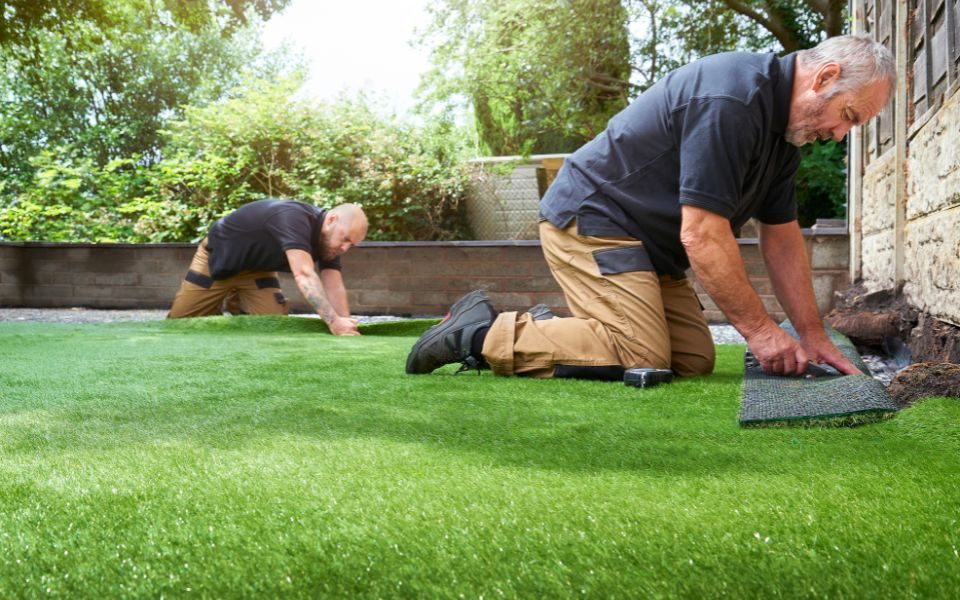
How Often Should Artificial Grass Be Replaced?
How Often Should Artificial Grass Be Replaced? The frequency of replacing artificial grass depends on various factors such as the quality of the yarns, backing, level of usage, and maintenance practices. On average, high-quality artificial grass should last anywhere from 15 to 20 years or even longer with proper care. However, in high-traffic areas or under extreme weather conditions, it’s lifespan may be shorter. Regular maintenance, including cleaning, brushing up, and occasional repairs, can help extend the lifespan of your artificial grass. Ultimately, the decision to replace artificial grass should be based on its condition, such as excessive wear and tear, fading, flattening or matting that cannot be remedied through maintenance.
Artificial grass has become increasingly popular in Milton Keynes, in fact, in general across the world, for its low maintenance and durability, but like any outdoor surface, it requires periodic replacement to maintain its quality and aesthetics. In this article, I will explain the factors influencing the lifespan of artificial grass and provide guidance on when it should be replaced.
Factors influencing the lifespan of artificial grass
Quality of the material
The quality of the artificial grass yarns and backing plays a significant role in determining its lifespan. Higher-quality materials are more durable and resistant to wear and tear, resulting in a longer lifespan.
Level of usage
The level of usage the artificial grass receives will impact its longevity. High-traffic areas, such as sports fields or kids playgrounds, may experience more wear and tear and require more frequent replacement compared to areas with lighter usage.
Maintenance practices
Proper maintenance can extend the lifespan of artificial grass surfaces. Regular brushing, cleaning, and removing debris can prevent matting and prolong the life of the grass. If you have dogs, it is also advisable to use enzyme cleaners to help reduce bacteria from their urine. Neglecting maintenance tasks can accelerate wear and require earlier replacement.
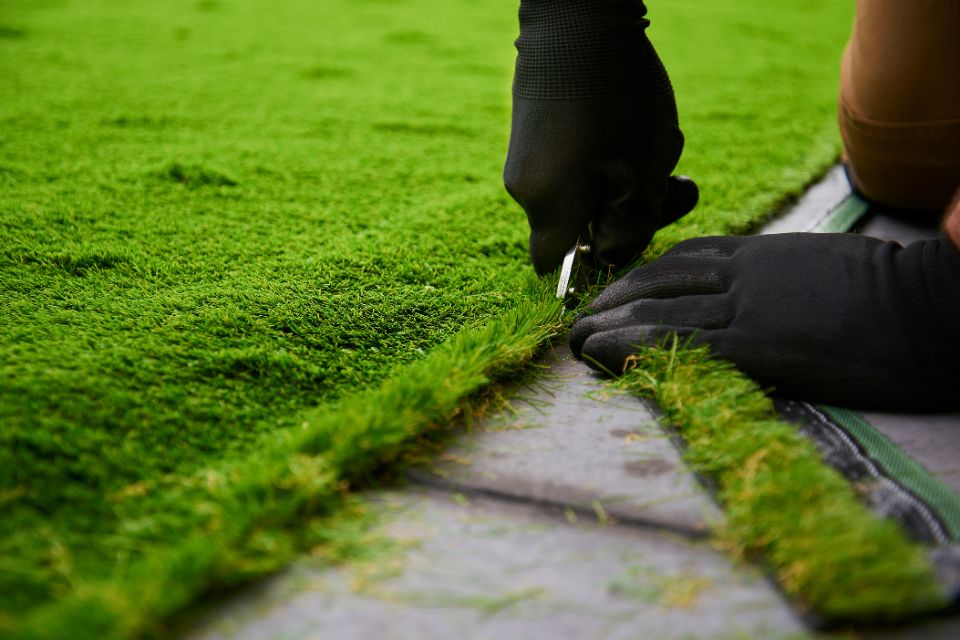
Signs indicating it’s time to replace artificial grass
Excessive wear and tear
Over time, artificial grass may show signs of wear and tear, such as fraying, bald spots, or matting. These signs indicate that the grass fibres are breaking down and losing their resilience, necessitating replacement.
Fading
Though very rare, exposure to extremely high sunlight and weather conditions can cause artificial grass to fade over time. Faded grass do not only look less appealing but may also indicate degradation of the material, prompting the need for replacement.
Drainage issues
Artificial grass is designed to have proper drainage, but over time, drainage systems may become clogged or ineffective. Standing water on the surface or poor drainage beneath the grass can lead to mould, mildew, and other issues, necessitating replacement.
How often should artificial grass be replaced?
General lifespan
On average, high-quality artificial grass can last anywhere from 15 to 20 years or even longer with proper care and maintenance. However, the actual lifespan may vary depending on factors such as usage, climate, and maintenance practices.
Replacement intervals
There is no set timeframe for when artificial grass should be replaced, as it depends on various factors specific to each installation. Some areas may require replacement sooner due to heavy usage or harsh weather conditions, while others may last longer with lighter usage and proper maintenance.
Visual inspection
Regularly inspecting the artificial grass for signs of wear and tear, fading, or drainage issues can help determine when replacement is necessary. If the grass looks worn, damaged, or no longer performs as intended, it may be time for replacement.
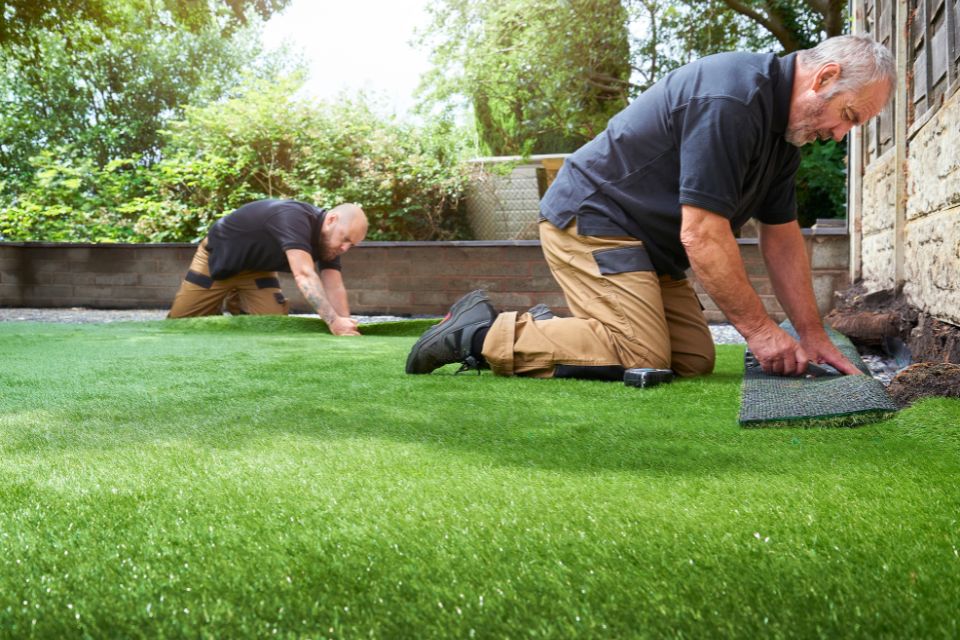
FAQs (Frequently Asked Questions)
Q1: How often should I inspect my artificial grass for signs of wear and tear?
It’s recommended to inspect your artificial grass periodically, at least once every few months, to check for any signs of damage or deterioration.
Q2: Can artificial grass be repaired instead of replaced?
In some cases, we can repair most artificial grass damages. We can be repair through patching. However, extensive damage or degradation may require replacement of part or the entire surface.
Q3: Does climate affect the lifespan of artificial grass?
Yes, climate can impact the lifespan of artificial grass. Extreme temperatures, prolonged exposure to sunlight, and excessive moisture can accelerate degradation and necessitate earlier replacement.
Q4: How does heavy usage affect the lifespan of artificial grass?
Areas with heavy foot traffic or frequent use, such as sports fields or kids playgrounds, may experience more wear and tear and require more frequent replacement compared to areas with lighter usage.
Q5: Can artificial grass be recycled?
Yes, many artificial grass products are recyclable. When replacing artificial grass, consider recycling options such as the ARTTRAGrass® EcoGrass which is a 100% recyclable, and particularly suited to residential gardens, to minimise environmental impact and promote sustainability.
Q6: Are there specific maintenance tasks that can extend the lifespan of artificial grass?
Yes, regular maintenance tasks such as brushing, cleaning, and removing debris can help extend the lifespan of artificial grass by preventing matting and maintaining proper drainage.
Q7: How can I protect my artificial grass from fading?
To protect artificial grass from fading, consider installing shade structures or using UV-resistant coatings. Additionally, regular cleaning and maintenance can help preserve the colour and appearance of the grass.
Q8: What should I do if I notice drainage issues with my artificial grass?
If you notice drainage issues such as standing water or poor drainage beneath the grass, contact our professional installation team to assess the situation and recommend appropriate repairs or replacement.
Q9: Can artificial grass be installed over existing natural grass?
In some cases, artificial grass can be installed over existing natural grass, but proper preparation and drainage are essential to ensure a successful installation. Contact our professional installation team for guidance on this.
Q10: Are there any warranties available for artificial grass?
Many artificial grass manufacturers offer warranties on their products, covering defects in materials and workmanship. ARTTRAGrass Milton Keynes Artificial Grass offer 10 years warranty on our artificial products and an exceptional aftercare service.
Final Thoughts on How Often Artificial Grass Should Be Replaced
Artificial grass offers numerous benefits, but like any outdoor surface, it may require replacement over time due to wear and tear, fading, or damage. By understanding the signs indicating the need for replacement and investing in high-quality materials and professional installation by our team, property owners can ensure their artificial grass continues to enhance their outdoor spaces for years to come.
If you a looking for a reputable artificial grass installer in Milton Keynes, Bedfordshire, Berkshire, Buckinghamshire, Cambridgeshire, Hertfordshire, Northamptonshire, Oxfordshire, or London, do not hesitate to contact us at 0800 433 2353. Alternatively, you can contact us via email at enquiries@miltonkeynesartificialgrass.co.uk or click here.
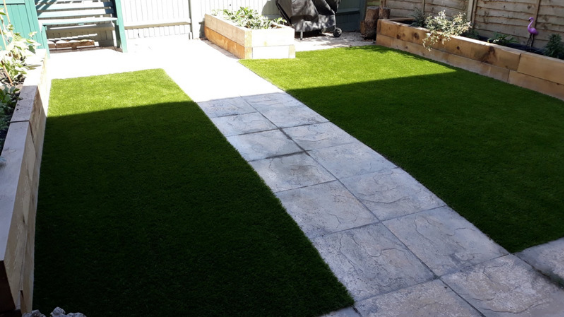
Choosing the Best Quality Artificial Grass in Milton Keynes
Are you looking to buy the best artificial grass in Milton Keynes? Artificial grass has become an increasingly popular choice for homeowners, businesses, and sports facilities looking for a low-maintenance and aesthetically pleasing alternative to natural grass. If you’re considering artificial grass in MK, you’re in luck – the city boasts one of the best providers in the industry: Milton Keynes Artificial Grass. In this article, I will explain everything you need to know about faux grass and help you make an informed decision when choosing the best quality for your needs.
Understanding Artificial Grass
What is Artificial Grass?
Artificial grass, also known as synthetic turf or fake grass, is a surface made from synthetic fibres designed to mimic the look and feel of natural grass. It’s commonly used in residential lawns, commercial landscapes, sports fields, and other applications where the benefits of low maintenance and year-round greenery are desired.
How is Artificial Grass Made?
The production of artificial grass involves weaving together synthetic fibres, typically made of polyethylene or polypropylene, into a mat. These fibres are then attached to a backing material and often filled with a layer of crumb rubber or sand to provide stability and a more natural feel. The manufacturing process has evolved, leading to more lifelike and durable artificial grass options.

Benefits of Artificial Grass
- Low Maintenance: Artificial grass requires minimal maintenance compared to natural grass. No mowing, watering, or fertilizing is needed.
- Year-Round Greenery: Artificial grass stays lush and green throughout the year, regardless of weather conditions.
- Cost-Effective: While the initial installation cost may be higher, artificial grass pays off in the long run due to reduced maintenance expenses.
- Water Conservation: Since fake turf doesn’t need watering, it helps conserve water, making it an environmentally friendly choice.
- Durability: High-quality artificial grass is designed to withstand heavy foot traffic and various weather conditions, ensuring longevity.
Choosing the Right Artificial Grass in Milton Keynes
Factors to Consider
- Quality of Materials: Look for artificial grass made from high-quality materials that can withstand UV rays, temperature changes, and heavy use.
- Pile Height: Pile height refers to the length of the grass blades. Consider your preferences and the intended use when choosing the right pile height.
- Density: A denser turf with more fibres per square inch generally indicates higher quality. It also contributes to a fuller and more realistic appearance.
- Infill Material: The infill provides stability and support to the fake lawn. Common materials include sand and rubber, and the choice depends on factors like drainage and desired softness.
- Colour and Texture: Opt for artificial grass that closely resembles natural grass in colour and texture for a more authentic look.
Milton Keynes Artificial Grass – The Best Choice
When it comes to finding the best quality artificial grass in Milton Keynes, look no further than ARTTRAGrass® brand. Their commitment to excellence and customer satisfaction sets them apart as the leading provider in the region.
Why Choose Milton Keynes Artificial Grass?
- Premium Quality: MK Artificial Grass offers top-tier synthetic turf that meets the highest standards of quality and durability.
- Variety of Options: Whether you need artificial grass for a residential lawn, commercial property, or sports field, they have a diverse range of options to suit your specific needs.
- Expert Installation: In addition to providing quality products, Milton Keynes Artificial Grass ensures professional installation, guaranteeing a flawless and long-lasting result.
- Environmentally Friendly: The materials used by Milton Keynes Artificial Grass are environmentally friendly, contributing to sustainability while providing a green and vibrant landscape.
Frequently Asked Questions
1. Where can I buy the best artificial grass in Milton Keynes?
MK Artificial Grass is renowned as the best provider of artificial grass in the area. You can contact us directly through our website and arrange a home visit to explore the variety of options available.
2. What sets Milton Keynes Artificial Grass apart from other providers?
MK Artificial Grass stands out due to its commitment to premium quality, a diverse range of options, expert installation, and environmental sustainability. These factors make them the top choice for artificial grass in Milton Keynes.
3. Can I choose different pile heights for my artificial grass?
Yes, MK Artificial Grass offers a range of pile heights to cater to individual preferences and the intended use of the artificial grass. Their knowledgeable staff can assist you in choosing the most suitable option for your needs.
4. Is artificial grass suitable for pets?
Absolutely. Many of Milton Keynes Artificial Grass’s products are pet-friendly and designed to withstand the wear and tear associated with active pets. Additionally, artificial grass is easy to clean and doesn’t harbour pests like natural grass.
5. How long does artificial grass last?
High-quality artificial grass, especially when professionally installed and maintained, can last up to 15 years or more. MKAG provides durable products that stand the test of time.
6. Does Milton Keynes Artificial Grass offer a warranty on their products?
Yes, MK Artificial Grass typically offers a warranty on their products, ensuring customer satisfaction and peace of mind. Be sure to inquire about specific warranty details when making a purchase.
7. Can I install artificial grass myself, or should I hire professionals?
While DIY installation is possible, it’s highly recommended to enlist the services of professionals for a flawless and long-lasting result. Milton Keynes Artificial Grass provides expert installation to ensure optimal performance and aesthetics.
8. How does artificial grass fare in different weather conditions?
Artificial grass is designed to withstand various weather conditions, including rain, snow, and UV exposure. MK Artificial Grass offers products that are specifically engineered to endure the local climate, ensuring all year round greenery.
9. Does artificial grass require any maintenance?
While artificial grass is low-maintenance compared to natural grass, some basic care is recommended. Regular brushing to keep the fibres upright and occasional cleaning to remove debris will help maintain the appearance of your artificial lawn. MK Artificial Grass provides guidelines for proper maintenance.
10. Can I use artificial grass in commercial spaces?
Certainly. MK Artificial Grass offers commercial-grade synthetic turf suitable for various commercial applications, such as office landscapes, retail spaces, and event venues. Their range of options allows you to find the perfect solution for your commercial needs.
Why we provide the best artificial grass in Milton Keynes
In conclusion, choosing synthetic lawn in Milton Keynes is made easy with the premier offerings of MK Artificial Grass. From residential lawns to sports fields and commercial spaces, their commitment to quality, variety, and expert installation ensures a green and vibrant landscape that stands the test of time. Make the smart choice for artificial grass – choose Milton Keynes Artificial Grass for the best quality and service.
If you a looking for a reputable company to supply and install fake turf in Milton Keynes, do not hesitate to contact us via email at info@miltonkeynesartificialgrass.co.uk or at 0800 433 2353
